How To Deter Deer From Garden Yard
First-time homeowners and people who are new to gardening may be excited when they first see deer in their yards. However, after the deer work through their property, those homeowners might find their fruit trees chewed to nubs and their garden destroyed.
Deer can quickly decimate decorative trees, shrubs and fruit trees. These animals also make short work of vegetable gardens. Deer can also carry ticks that spread Lyme disease, a debilitating illness that affects both people and dogs.
For these reasons, many people prefer to keep deer completely off their property and Havahart® will show you how.
Check our our All-in-One Havahart® Deer Repellent Kit and protect your property »
How to Protect Your Trees and Plants from Deer
Deer are smarter than we often give them credit. The most successful strategy to protect trees, plants, and gardens from deer is to keep them guessing and use a variety of methods to keep them away from your landscape. Havahart® offers these 17 ideas to add to your arsenal of options to stop deer from intruding in your yard:
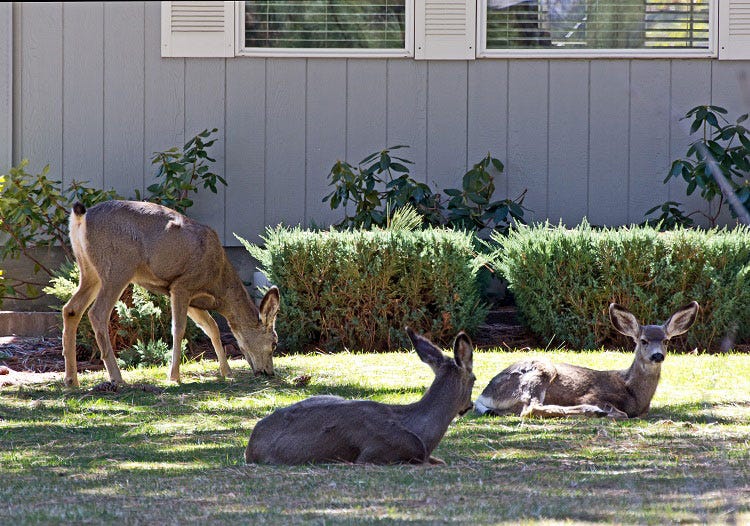
1. Eliminate deer attractants. If you have a vegetable garden or fruit trees, harvest produce as soon as it is ready. This will prevent deer from seeing (or smelling) something tasty and deciding your yard is an all-you-can-eat buffet.
2. Keep deer-attracting plants closer to your home.This is especially important during spring when mother deer are providing food for their fawns. They enter yards in search of delicious plants that are high in protein and nutrients. During this time, deer love to feast on English Ivy and a variety of vegetable plants like peas and lettuce. Any fruit-bearing trees or vines will also be targeted. Deer enjoy the sweet taste of strawberries and peaches as well as many flowers, including pansies and impatiens. Grow these plants closer to your home and within eyesight of your windows. Even hungry deer are reluctant to come so close to a human dwelling.
3. Maintain your landscape. Don't make your yard a cozy place for visiting deer. You don't want to tempt them into bedding down for the night or resting there in the day. Trim densely planted areas to make them seem less appealing as hiding places. Deer prefer areas that offer quick cover in the case of predators, so eliminating that cover will discourage deer from hanging out in your yard.
4. Spray them with a motion-activated sprinkler.Underground sprinkler systems on timers as well as motion-activated water sprinklers are often used to keep deer away from certain garden beds and trees. For a more advanced solution, try theCritter Ridder® Motion Activated Animal Repellent Sprinkler. This sprinkler detects movement with infrared technology, day or night. This great tool startles animals with a blast of harmless water and emits a sound to scare them. As a bonus, the Critter Ridder® is effective for chasing other pesky critters away, too. It's adjustable, easy to set up and environmentally friendly.
5. Add levels to your yard.Deer don't enjoy climbing up or down steep or sheer slopes. A yard that seems difficult to navigate can deter deer immediately. Sunken beds, terraces, and stacked chopped wood can be added to the landscape to prevent deer from entering too far into your yard. When deer see these, they are afraid to jump or climb on them and will find somewhere else to graze. Keep potted plants up on the deck or porch, deer will likely not attempt to climb stairs to reach them.
6. Let your dog spend plenty of time in the yard. Chances are if your dog spots a deer, it will bark. The deer will run and may eventually decide your yard isn't a safe place to graze.
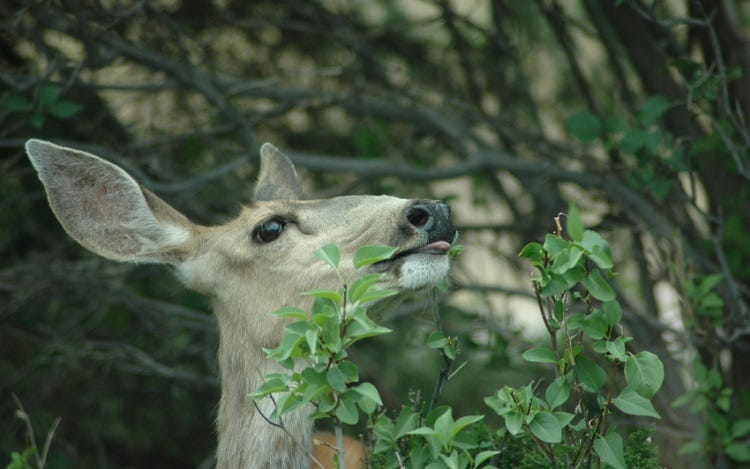
7. Use plants and shrubs as taste-based repellents. Deer rely heavily on their sense of smell. If something smells unappealing to them, they will avoid it. Deer develop preferences for plants and trees that taste good, just like humans do. If you can make your trees unappealing to a deer's sense of smell and taste, it will likely go elsewhere for food. For these reasons, some homeowners plant pungent herbs and other plants around the trees and shrubs they want to protect. This may help to a degree, but you will find that deer, like people, have different preferences. You could accidentally plant something that your deer find absolutely delicious!
For these reasons, some homeowners plant pungent herbs and other plants around the trees and shrubs they want to protect. This may help to a degree, but you will find that deer, like people, have different preferences. You could accidentally plant something that your deer find absolutely delicious!
Some deer-repelling plants with strong aromas include lavender, catmint, garlic or chives. Because they are thorny, roses are sometimes a good choice as well, but some deer find roses to be a wonderful snack. Check out our full list of deer resistant plants here.
With any type of deer-resistant plants, you'll learn by trial and error which plants are not favored by the deer where you live. Try asking other homeowners and gardeners to get an idea of the plants they use to repel deer.

8. Use plants and shrubs as texture-based repellents.Poisonous plants, such as daffodils, are avoided by deer. Mullein or lamb's ear has a texture that deer don't like. Shrubs like Russian olive, boxwood and oleander are also unappealing to deer because they are prickly and not pleasant to chew. Keep in mind, though, that while these are not plants that deer prefer, if a deer is hungry enough, it will eat whatever it can find. That's why there are no deer-proof plants — only deer-resistant ones.
Keep in mind that some deer-repelling plants can quickly overwhelm your yard. For example, catmint and mullein are sometimes considered weeds because they spread quickly and grow well in less-than-ideal conditions. Be sure to research anything before you plant it so you understand its growing habits and how to keep it controlled.
9. Use hedges to create a border. Boxwoods and other thick hedges can be used to keep deer out. These plants line the yard's perimeter and act as a border or a wall, deterring deer from crossing through. Because deer can't see through the hedges into the yard, they may decide to skip your yard and head elsewhere because it's too risky for them to proceed. Keep hedges well maintained so they stay full and continue to block the view into your yard.
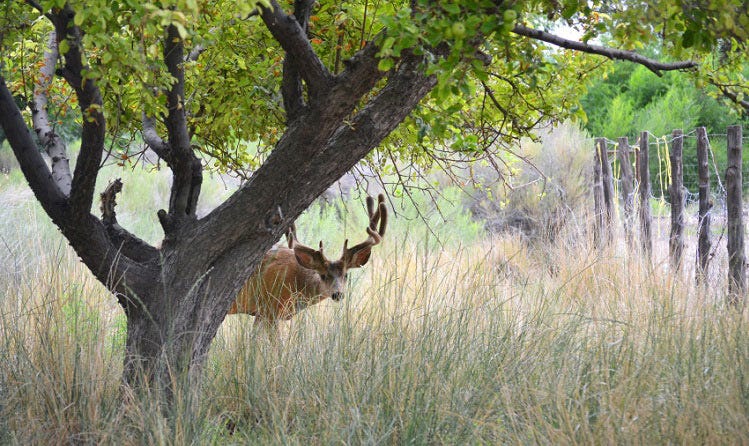
10. Build a fence.Adding a strong, tall fence all the way around your property may keep most deer out. However, deer can jump quite high. A good rule of thumb is to build your fence at least eight feet tall and don't leave any gaps wider or taller than six inches. Keep your fence well-maintained so that deer don't find a way to squeeze in.
11. Apply proven deer repellents. Deer repellent products are effective in obstructing a deer's sense of smell and taste.Deer Off® products are ideal repellents to apply to your trees because they affect both senses. These repellents emit a scent that reminds deer of a decaying animal. This signals deer and other animals to vacate the yard. Additionally, the repellent tastes like garlic which makes it unappealing to deer.
The Department of Natural Resources at Cornell University states that these repellents "can reduce browsing on individual shrubs or trees by 50-75%." Deer Off® lasts up to 90 days with one application.
For best results, you should treat your trees with a repellent before the deer start nibbling on them. They typically feed on trees in the autumn through early spring (approximately October through February). During this time frame, female deer are most hungry. When you use deterrents early, before deer find grazing sites, they learn early in the season to avoid your plants and are less likely to investigate the area again.
Shop Havahart® Deer Repellents »
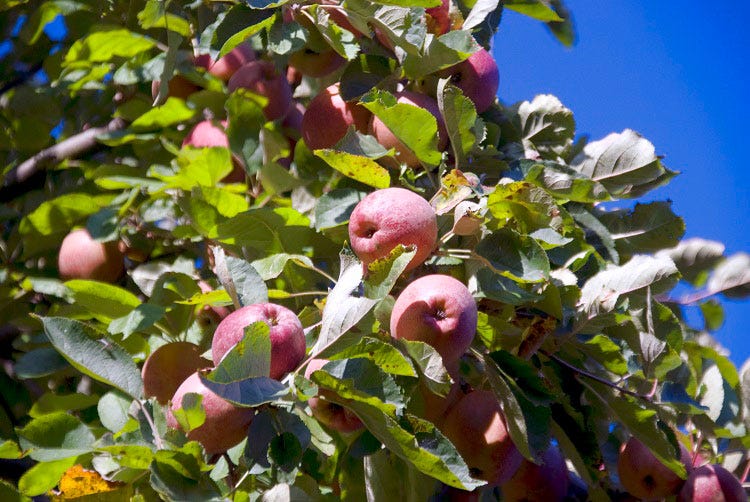
12. Install plant nets or tree wraps. Tree wraps are also commonly used to prevent deer from nibbling and rubbing their antlers on trees. However, wraps are not attractive, and sometimes deer are smart enough to knock them off the tree. If you use wraps to prevent antler rubbing, be sure to install them in the fall when deer start marking their territories. Netting can also be used to prevent deer from getting at your plants. Place the net over bushes, across fruit trees and overtop bulbs to protect them from deer. The nets allow your plants to still get water and light but keep them protected. It's especially important to wrap or cover young plants as they are in their most vulnerable stage.
13. Put up wind chimes.Repellent sprays are perfect when deer are eating your trees, but how do you keep deer away from trees when they want to use them as a rubbing post? One of the best ways is to startle them so they think the area is unsafe. Wind chimes, which make noise unexpectedly, are a good start. However, deer tend to adjust quickly, and they may ignore those chimes when they hear them often. It's best to keep deer guessing by adding a variety of wind chimes in both metal and wood materials. While you shouldn't rely solely on wind chimes to do the trick, it's a simple solution to tackling your deer problem.
14. Incorporate "busy" décor into your landscape. Along the same line as wind chimes, you can add some moving decorations to your yard that spin, wiggle, whistle or rotate with the help of solar or wind power. Unusual movements and sounds will make deer wary to enter your yard.
15. String up fishing line.Create a border around a plant bed or other area that attracts deer using fishing line. String the fishing line two to three feet above ground and pull it taut. Deer become confused by this barrier and will eventually give up in frustration.
16. Install electronic posts.Another great tool to try in conjunction with the Critter Ridder® Motion Activated Animal Repellent Sprinkler is theElectronic Deer Repellent .It allows you to keep a natural-looking landscape without having to install an unattractive (and expensive) fence to keep deer away from trees and shrubs.
These unassuming posts smell like acorns to entice deer to investigate them. Once they touch the post, they get a mild shock. It's not enough to hurt them. Instead, it startles them and discourages them from returning.
These posts can be moved to other areas of your yard as needed. You don't have to worry about being close to a power source because they are operated by a long-life battery, making them ideal for remote parts of your property.
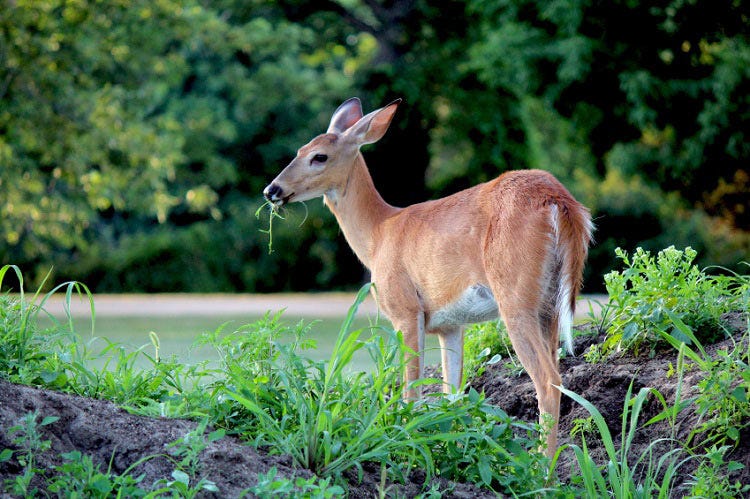
17. Rotate your deer-repellent tools. If you use a variety of these deer-repellent methods throughout your yard, you'll really make deer work for a meal. In a few weeks, move your Deer Off® from one place to another or add Critter Ridder® to another plant that has suddenly piqued a hungry deer's interest. An ever-changing environment will confuse deer and discourage them from making your yard a favorite stop.
Your Plan to Repel Deer
Deer are smart, much to the frustration of homeowners who value their trees and landscaping. However, by understanding deer and learning what they like and dislike, you can take action against their destructive habits. With our deer-repellent products from Havahart® and these other ideas, you can protect your trees and other valuable plants from these and other animals.
Are you having trouble with deer? Contact our customer service center at 1-855-5-HAVAHART or ask online for personalized advice on keeping deer out of your yard and garden. You can also show off your deer-repelling efforts when you visit Havahart® on Facebook.
For more advice and exclusive updates on Havahart® products, subscribe to our eNewsletter.
How To Deter Deer From Garden Yard
Source: https://www.havahart.com/articles/keep-deer-off-your-property
Posted by: coopertherof.blogspot.com

0 Response to "How To Deter Deer From Garden Yard"
Post a Comment